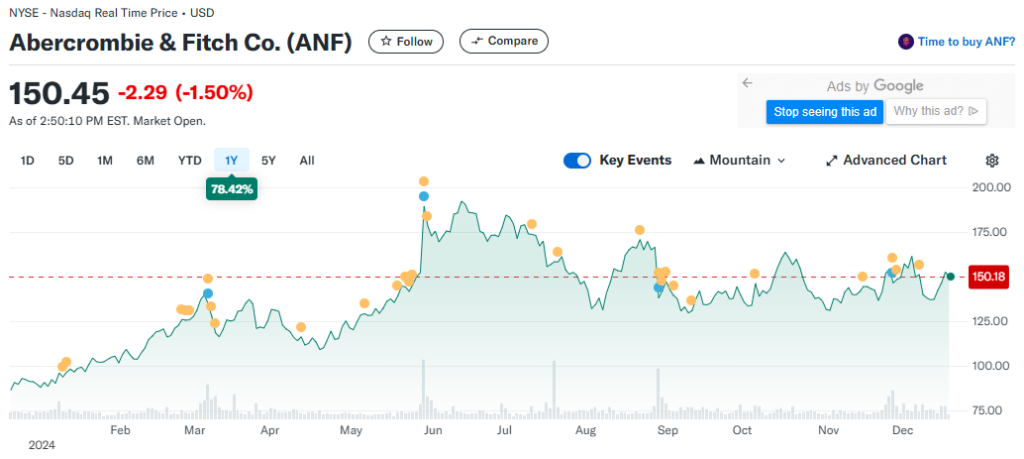Abercrombie & Fitch Co. (NYSE: ANF) has undergone a remarkable transformation over the years, evolving from a brand associated with teenage fashion trends to a more sophisticated and inclusive retailer. This transformation, coupled with an evolving retail landscape, makes the company an intriguing option for investors. In this article, we’ll explore Abercrombie & Fitch’s business model, financial health, growth strategies, and the factors that could influence its future prospects.
Company Overview
Founded in 1892, Abercrombie & Fitch Co. is a global retailer that operates under two main brands: Abercrombie & Fitch (A&F) and Hollister Co. These brands cater to distinct market segments. While Abercrombie & Fitch targets young adults with a focus on casual, premium-quality clothing, Hollister is designed for teenagers, offering a laid-back, beach-inspired aesthetic.
Abercrombie & Fitch has approximately 730 stores worldwide, complemented by a strong e-commerce presence. The company’s omnichannel strategy ensures it remains competitive in a retail environment increasingly dominated by online shopping.
Industry Dynamics
The retail industry has faced significant upheavals in recent years, with e-commerce growth, changing consumer preferences, and supply chain challenges reshaping the landscape. For Abercrombie & Fitch, adapting to these changes has been crucial.
Key industry trends influencing Abercrombie & Fitch include:
- Digital Transformation: The rise of online shopping has shifted consumer behavior. Retailers must invest in user-friendly websites, mobile apps, and data-driven marketing strategies.
- Sustainability: Consumers are increasingly demanding sustainable practices from brands. Retailers must incorporate eco-friendly materials and ethical production methods.
- Personalization: Tailored shopping experiences, whether through AI-driven product recommendations or curated in-store experiences, are becoming a competitive differentiator.
- Global Expansion: Emerging markets, particularly in Asia, offer significant growth opportunities for retailers looking to expand their footprint.
Strategic Initiatives
1. Brand Repositioning
Abercrombie & Fitch has successfully repositioned its brand to appeal to a broader demographic. The company’s shift from its past emphasis on exclusivity and aspirational marketing to inclusivity and authenticity has resonated with modern consumers. Campaigns featuring diverse models and body-positive messaging have helped redefine the brand’s image.
2. E-Commerce Growth
E-commerce has been a cornerstone of Abercrombie & Fitch’s growth strategy. The company’s investment in digital capabilities, including a revamped website, mobile app, and efficient fulfillment processes, has paid off. E-commerce now accounts for a significant portion of total sales, demonstrating the company’s ability to adapt to changing shopping habits.
3. Store Optimization
Abercrombie & Fitch has been optimizing its store portfolio by closing underperforming locations and opening smaller, more efficient stores in high-traffic areas. These stores focus on creating immersive shopping experiences, blending physical and digital elements.
4. Sustainability Initiatives
The company’s commitment to sustainability includes using sustainable materials, reducing water usage in production, and ensuring ethical labor practices. These efforts align with consumer expectations and enhance the brand’s appeal to environmentally conscious shoppers.
Financial Performance

Revenue Trends
Abercrombie & Fitch has demonstrated resilience in the face of industry challenges. The company’s revenues have been driven by strong performance in both its Abercrombie and Hollister brands. Growth in digital sales, international markets, and strategic pricing initiatives has contributed to this performance.
Profitability
The company’s focus on cost efficiency and strategic investments has led to improved profitability. Operating margins have benefited from disciplined inventory management and efforts to streamline operations. However, ongoing inflationary pressures and supply chain disruptions remain challenges.
Balance Sheet
Abercrombie & Fitch’s balance sheet reflects prudent financial management. The company has reduced debt levels and maintained healthy liquidity, positioning it well to weather economic uncertainties and invest in growth initiatives.
Competitive Landscape
Abercrombie & Fitch operates in a highly competitive retail sector, facing competition from:
- Specialty Retailers: Brands like American Eagle Outfitters and Urban Outfitters cater to similar demographics, requiring Abercrombie & Fitch to differentiate through product quality and brand positioning.
- Fast Fashion Players: Companies like H&M and Zara offer trendy clothing at lower price points, challenging Abercrombie’s pricing strategy.
- Direct-to-Consumer Brands: Emerging DTC brands leverage social media and digital marketing to attract younger consumers, posing a threat to traditional retailers.
Abercrombie’s ability to compete hinges on its brand differentiation, customer loyalty, and ability to adapt to changing trends.
Growth Opportunities
1. International Expansion
Emerging markets, particularly in Asia and the Middle East, represent significant growth opportunities for Abercrombie & Fitch. The company’s global presence can be further enhanced through partnerships, localized marketing, and tailored product offerings.
2. Product Diversification
Expanding product categories, such as activewear and loungewear, allows Abercrombie & Fitch to tap into growing segments. Collaborations with designers or influencers can also drive interest in limited-edition collections.
3. Technology Integration
Investments in technology, including artificial intelligence and data analytics, can enhance personalization, optimize supply chains, and improve customer engagement. Abercrombie’s focus on digital innovation positions it well to capitalize on these opportunities.
4. Sustainability Leadership
By furthering its sustainability efforts, Abercrombie & Fitch can strengthen its brand equity and attract environmentally conscious consumers. Transparent reporting and ambitious sustainability goals will be key to achieving leadership in this area.
Risks to Consider
1. Economic Uncertainty
Macroeconomic factors, including inflation, interest rate hikes, and potential recessions, could dampen consumer spending on discretionary items like apparel.
2. Supply Chain Challenges
Global supply chain disruptions, including rising shipping costs and delays, may impact Abercrombie’s ability to deliver products on time and maintain margins.
3. Competitive Pressures
The retail sector’s competitive nature requires continuous innovation and adaptation. Failing to stay ahead of trends could erode Abercrombie’s market share.
4. Brand Perception
Maintaining a positive brand image is critical. Any missteps in marketing or product quality could lead to reputational damage and loss of customer loyalty.
Investment Outlook
Abercrombie & Fitch Co. has demonstrated its ability to adapt to a rapidly changing retail environment. The company’s focus on brand repositioning, digital transformation, and sustainability aligns with key industry trends and consumer expectations. While challenges such as economic uncertainty and supply chain issues persist, Abercrombie’s strategic initiatives and financial discipline position it well for long-term growth.
Valuation Metrics
Investors should evaluate Abercrombie’s valuation metrics, including price-to-earnings (P/E) ratio, enterprise value-to-EBITDA (EV/EBITDA), and price-to-sales (P/S) ratio, relative to its peers. Comparing these metrics can provide insights into the stock’s attractiveness.
Dividend Policy
Abercrombie & Fitch’s dividend policy reflects its focus on reinvestment and balance sheet strength. While dividends may appeal to income-focused investors, the company’s growth potential offers opportunities for capital appreciation.
Conclusion
Abercrombie & Fitch Co. represents a compelling investment opportunity for those seeking exposure to the retail sector. The company’s transformation, strong brand positioning, and commitment to innovation provide a solid foundation for growth. However, potential investors should carefully consider the risks and remain vigilant about industry dynamics.
For long-term investors with a moderate risk tolerance, Abercrombie & Fitch’s evolving strategies and resilience make it a stock worth considering. As always, conducting thorough due diligence and staying informed about market trends will be critical to making an informed investment decision.











